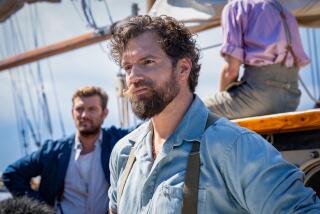Master of the seas
If some are born to command, Russell Crowe was born to play commanders. Few actors can be as convincing as leaders of men, and to see Crowe as Capt. Jack Aubrey in âMaster and Commander: The Far Side of the Worldâ is to see a consummate performer doing what he does best.
Whether heâs peering through a spyglass, standing straight up in the rigging, looking nonchalant in the face of gale force winds or barking incomprehensible but forceful nautical commands, Croweâs Aubrey has an unflappable self-confidence. Ease is a great thing in an actor, and when itâs combined with Croweâs stated intent to play this 1805 British sea captain as someone ânot always right but always certain,â the result is a performance that shows how much impeccable physical presence can accomplish.
For the record:
12:00 a.m. Nov. 20, 2003 For The Record
Los Angeles Times Thursday November 20, 2003 Home Edition Main News Part A Page 2 National Desk 0 inches; 22 words Type of Material: Correction
Actorâs name -- The review of âMaster and Commanderâ in Fridayâs Calendar misspelled the last name of actor Max Pirkis as Perkis.
Directed by Peter Weir from a script he co-wrote with John Collee, âMaster and Commanderâ intends to be an intelligent epic, but itâs the epic qualities more than the intelligence that hold us. While Crowe is the rare heroic actor who can handle any kind of psychologically complex role (witness âThe Insiderâ and âA Beautiful Mindâ), heâs not really called on to do that here. That the film succeeds despite a relative lack of depth and emotional involvement shows how powerfully effective it is in doing what it does best: re-creating an extended nautical duel between Aubreyâs HMS Surprise and the French (changed from the American in the original novel) privateer Acheron.
âMaster and Commanderâ is based on two of the 20 novels written by Patrick OâBrian in a series called the Aubrey-Maturin novels after the captain and his best friend and shipmate, Dr. Stephen Maturin (played by Paul Bettany). As an article in the Writerâs Chronicle concludes, âPerhaps only the Harry Potter books and âThe Lord of the Ringsâ have inspired literary cults with more zealots and accessories.â
In addition to some 3 million copies of the novels, devotees, writes D.W. Fenza, can choose from âtwo sets of unabridged audio recordings; two CDs of classical music favored by fiddle-playing Capt. Aubrey and cello-playing Stephen Maturin; numerous Web sites; a CD of seafaring songs favored by Aubreyâs shipmates ... even a cookbook, which reveals the artery-occluding recipes of Jack Aubreyâs favorite puddings, Spotted Dog and Drowned Baby.â
Perhaps the most essential accessory is âA Sea of Words: A Lexicon and Companion for Patrick OâBrianâs Seafaring Tales,â which defines more than 3,000 (out of a potential 8,000) of the bookâs âarcane and complexâ words and phrases. This overwhelming specificity points to one of the novelsâ key lures: Written by a man who felt âauthenticity is a jewel,â these books re-create the all-male universe of naval warfare during the Napoleonic era down to the smallest detail, making a world that is so tangible itâs easy for readers to get lost in it.
Veteran Australian director Weir, whose career extends from home country classics like âPicnic at Hanging Rockâ and âThe Last Waveâ all the way through âWitnessâ and âThe Truman Show,â has gone to extraordinary lengths to capture on film that enticingly detailed world and, using a variety of methods, heâs succeeded admirably.
For starters, âMaster and Commanderâ has been well cast, using mostly unfamiliar British actors to play the Surpriseâs key personnel, all of whom are very busy doing things we may not understand but intuitively follow. The same care extends to the selection of extras to play the background crew, with casting associate Judy Bouley looking at some 7,000 people to find the 100-plus most authentic-looking faces.
âMaster and Commanderâ also paid attention to getting the smallest of physical objects right. Buttons were ordered from a button-caster whoâs been in business since the 1770s; shoes were based on a well-preserved 1806 model; and Monmouth knit hats were made by a Welsh woman whose family has been making them since the 1700s.
This may sound fanatical to the point of derangement, but in the hands of Weir, his cast and production designer William Sandell, all this detail has an unmistakable cumulative impact. We really feel weâre on the Surprise; we struggle with the close quarters, the claustrophobia and the cabin fever just like the crew does, and that adds a level of intensity to the viewing experience.
Most intriguing of all, âMaster and Commanderâ delivers this degree of authenticity without going to sea at all. Though footage shot by a tall ship caught in a real-life around-the-Horn tempest was used in this filmâs convincing storm re-creation, the picture itself, beautifully photographed by Russell Boyd, was to a great extent shot in the same 6 1/2-acre tank in Mexico where James Cameron sank the Titanic.
The productionâs superlative visual effects crew, working with Asylum (which did the storm) and Industrial Light & Magic, used 735 effects shots to work its magic -- providing, for instance, the Acheron with rigging. Upward of 40 layers of waves and sky were used to compose a single picturesque frame. This use of CGI to mimic reality was something with which director Weir, who called it âapproaching the divine, daring to impersonate nature,â was understandably proud.
âMaster and Commanderâ begins with something else the filmmakers do well, and that is a rousing battle between the two ships, an encounter in which Aubreyâs Surprise, being much the smaller of the two, is very much at a disadvantage. Weir and company have well-orchestrated the bloody chaos of on-board combat, as well as the primitive conditions that ship surgeons like Maturin routinely worked under.
âMaster and Commanderâ is intent on making a conflict between good friends Maturin and Aubrey its emotional centerpiece. Maturin, the rational man of science, is set up as the audience surrogate, and when he gets concerned that Aubrey is getting obsessive in his pursuit of the Acheron, letting his personal grudge against the French vessel drive him to disregard the safety of his crew, we are supposed to get caught up in the clash. We do, but only to a limited extent.
Thatâs because, frankly, Crowe has done such powerful work of making Aubrey heroic that even Bettanyâs strong acting as the doctor canât make a dent in our regard, especially when his complaints revolve around what feels like the small potatoes issue of Maturinâs being denied a scientific visit to the Galapagos Islands that he was so looking forward to.
Weâve seen Aubrey being gracious and kind to a wounded boy midshipman (a poised Max Perkis), weâve noticed how the crew respects their âLucky Jack,â weâve even heard him make âCaptain Bloodâ-type speeches (âI know thereâs not a faint heart among youâ) surprisingly convincing. That this man could be a kind of Captain Bligh is simply out of the question.
âMaster and Commanderâ in a sense recognizes how strong a character Aubrey is by attempting to turn him into his own worst enemy: What worthier, more dangerous opponent could there be?
But while power might corrupt lesser men, thereâs not a chance here, and that turns out to be âMaster and Commanderâsâ point of vulnerability as well as its greatest, most enviable strength.
*
âMaster and Commanderâ
MPAA rating: PG-13, for intense battle sequences, related images and brief language
Times guidelines: Serious nautical gore and some brutal battles
Russell Crowe...Captain Jack Aubrey
Paul Bettany...Dr. Stephen Maturin
Billy Boyd...Barrett Bonden
James DâArcy...Thomas Pullings
Lee Ingleby...Hollom
Twentieth Century Fox, Universal Pictures and Miramax Films present a Samuel Goldwyn Films production, released by Twentieth Century Fox. Director Peter Weir. Producers Samuel Goldwyn Jr., Peter Weir, Duncan Henderson. Executive producer Alan B. Curtiss. Screenplay Peter Weir & John Collee, based on the novels by Patrick OâBrian. Cinematographer Russell Boyd. Editor Lee Smith. Costumes Wendy Stites. Music Iva Davies, Christopher Gordon & Richard Tognetti. Production design William Sandell. Supervising art directors Bruce Crone, Mark Mansbridge. Set decorator Robert Gould. Running time: 2 hours, 5 minutes.
In general release.
More to Read
Only good movies
Get the Indie Focus newsletter, Mark Olsen's weekly guide to the world of cinema.
You may occasionally receive promotional content from the Los Angeles Times.











